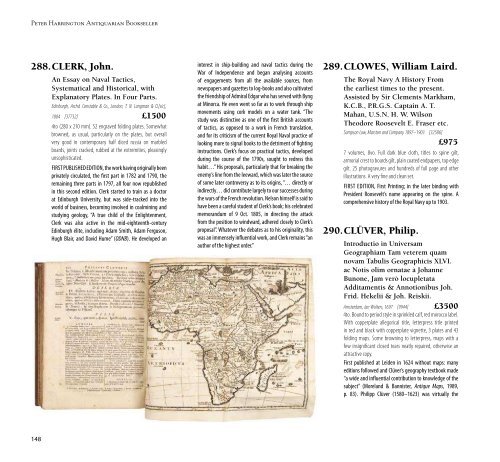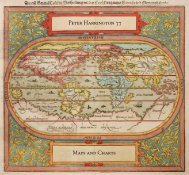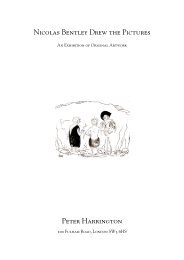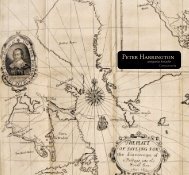antiquarian bookseller - Peter Harrington
antiquarian bookseller - Peter Harrington
antiquarian bookseller - Peter Harrington
Create successful ePaper yourself
Turn your PDF publications into a flip-book with our unique Google optimized e-Paper software.
<strong>Peter</strong> <strong>Harrington</strong> Antiquarian Bookseller<br />
288.CLERK, John.<br />
An Essay on Naval Tactics,<br />
Systematical and Historical, with<br />
Explanatory Plates. In Four Parts.<br />
Edinburgh, Archd. Constable & Co., London, T. N. Longman & O.[sic],<br />
1804 [37732] £1500<br />
4to (280 x 210 mm). 52 engraved folding plates. Somewhat<br />
browned, as usual, particularly on the plates, but overall<br />
very good in contemporary half diced russia on marbled<br />
boards, joints cracked, rubbed at the extremities, pleasingly<br />
unsophisticated.<br />
FIRST PUBLISHED EDITION, the work having originally been<br />
privately circulated, the first part in 1782 and 1790, the<br />
remaining three parts in 1797, all four now republished<br />
in this second edition. Clerk started to train as a doctor<br />
at Edinburgh University, but was side-tracked into the<br />
world of business, becoming involved in coalmining and<br />
studying geology, “A true child of the Enlightenment,<br />
Clerk was also active in the mid-eighteenth-century<br />
Edinburgh élite, including Adam Smith, Adam Ferguson,<br />
Hugh Blair, and David Hume” (ODNB). He developed an<br />
interest in ship-building and naval tactics during the<br />
War of Independence and began analysing accounts<br />
of engagements from all the available sources, from<br />
newspapers and gazettes to log-books and also cultivated<br />
the friendship of Admiral Edgar who has served with Byng<br />
at Minorca. He even went so far as to work through ship<br />
movements using cork models on a water tank. “The<br />
study was distinctive as one of the first British accounts<br />
of tactics, as opposed to a work in French translation,<br />
and for its criticism of the current Royal Naval practice of<br />
looking more to signal books to the detriment of fighting<br />
instructions. Clerk’s focus on practical tactics, developed<br />
during the course of the 1790s, sought to redress this<br />
habit…” His proposals, particularly that for breaking the<br />
enemy’s line from the leeward, which was later the source<br />
of some later controversy as to its origins, “… directly or<br />
indirectly… did contribute largely to our successes during<br />
the wars of the French revolution. Nelson himself is said to<br />
have been a careful student of Clerk’s book; his celebrated<br />
memorandum of 9 Oct. 1805, in directing the attack<br />
from the position to windward, adhered closely to Clerk’s<br />
proposal”. Whatever the debates as to his originality, this<br />
was an immensely influential work, and Clerk remains “an<br />
author of the highest order.”<br />
289.CLOWES, William Laird.<br />
The Royal Navy A History From<br />
the earliest times to the present.<br />
Assisted by Sir Clements Markham,<br />
K.C.B., P.R.G.S. Captain A. T.<br />
Mahan, U.S.N. H. W. Wilson<br />
Theodore Roosevelt E. Fraser etc.<br />
Sampson Low, Marston and Company 1897–1903 [32586]<br />
£975<br />
7 volumes, 8vo. Full dark blue cloth, titles to spine gilt,<br />
armorial crest to boards gilt, plain coated endpapers, top edge<br />
gilt. 25 photogravures and hundreds of full page and other<br />
illustrations. A very fine and clean set.<br />
FIRST EDITION, First Printing; in the later binding with<br />
President Roosevelt’s name appearing on the spine. A<br />
comprehensive history of the Royal Navy up to 1903.<br />
290.CLÜVER, Philip.<br />
Introductio in Universam<br />
Geographiam Tam veterem quam<br />
novam Tabulis Geographicis XLVI.<br />
ac Notis olim ornatae à Johanne<br />
Bunone, Jam verò locupletata<br />
Additamentis & Annotionibus Joh.<br />
Frid. Hekelii & Joh. Reiskii.<br />
Amsterdam, Jan Wolters, 1697 [9944] £3500<br />
4to. Bound to period style in sprinkled calf, red morocco label.<br />
With copperplate allegorical title, letterpress title printed<br />
in red and black with copperplate vignette, 3 plates and 43<br />
folding maps. Some browning to letterpress, maps with a<br />
few insignificant closed tears neatly repaired, otherwise an<br />
attractive copy.<br />
First published at Leiden in 1624 without maps: many<br />
editions followed and Clüver’s geography textbook made<br />
“a wide and influential contribution to knowledge of the<br />
subject” (Moreland & Bannister, Antique Maps, 1989,<br />
p. 83). Philipp Clüver (1580–1623) was virtually the<br />
founder of historical geography. This edition is based on<br />
that originally issued by Johannis Bunonis (Wolfenbuttel<br />
1661) but may be the first to include the additions by J. F.<br />
Hekelius and Joannes Reiskius.<br />
Philllips 4270; Burden, The Mapping of North America, 360; Sabin 13805.<br />
291.COOKE, Edward<br />
William.<br />
Sixty Five Plates of Shipping and<br />
Craft. Drawn and Etched.<br />
London, [?for the Author], 1828–31 [37093] £1500<br />
4to. 63 etched plates, etched title-page vignette and tail-piece<br />
to the plate list. Sporadic foxing and browning, as always, but<br />
overall very good, neatly recased in the original purple cloth,<br />
gilt, spine relined, sunned at the spine and edges, gilt edges.<br />
First thus, the first edition of 1829, originally issued in parts,<br />
having 50 plates only. The present issue was combined<br />
with his Twelve Plates of Coast Sketches: Brighton (1830)<br />
Catalogue 57: Travel Section 7: Mapping, Navigation and Naval History<br />
and The British Coast (1831). The child of George Cooke,<br />
a member of the Cooke family group of artists, engravers<br />
and publishers, Edward William was an artistic prodigy. He<br />
was employed at the age of nine making sketches from<br />
life at the nurseries of Conrad Loddige for use in Loudon’s<br />
Encyclopaedia of Plants, later working for the nurseryman<br />
himself on illustrations for the Botanical Cabinet. Around<br />
1825, when still in his teens, he worked for Clarkson<br />
Stansfield making studies of nautical details, and “In order<br />
to increase his acquaintance with ships, he studied under<br />
Captain Burton of the Thetis” (DNB). He travelled widely<br />
in Europe showing “a single-minded devotion to minutely<br />
observed portraits of smaller working craft, recording<br />
their appearance in every country he visited…” and with<br />
the arrival of steam (there are two steam craft amongst<br />
these plates) “…he developed an almost archaeological<br />
approach, recording as if aware that change was afoot”<br />
(ODNB). His watercolours were exhibited at the RA and<br />
British Institution and attracted favourable reviews<br />
– Ruskin was much taken with his Morning after a<br />
Heavy Gale exhibited at the RA in 1857 – and also the<br />
patronage of John Sheepshanks, Robert Vernon and<br />
William Wells, prominent collectors of modern art. He<br />
retained an interest in scientific matters throughout his<br />
life, nurturing an enthusiasm for geology, microscopy and<br />
also photography. He became a fellow of the Linnaean<br />
Society in 1857 and the Royal Society in 1863.<br />
292.CORBETT, Julian<br />
Stafford.<br />
The Campaign of Trafalgar.<br />
Longmans, Green and Co., London, 1919 [38625] £750<br />
2 volumes, 8vo. Recent navy blue full morocco, single ruled<br />
panel to the boards, raised bands to the spine, gilt fouled<br />
anchor devices to the compartments, red morocco title pieces<br />
and head-bands. Frontispiece and nine plans, all but 2 of them<br />
folding, 3 diagrams to the text. Light marginal browning,<br />
otherwise a very nice set, handsomely bound.<br />
New Edition. A lawyer by training, but a naval historian by<br />
avocation, Corbett became a lecturer at the Royal Naval<br />
War College in Greenwich in 1902 and began to generate<br />
a series of publications which more or less defined British<br />
naval thinking around the turn of the century. His Trafalgar<br />
was sufficiently controversial in its handling of Nelson’s<br />
tactics for a parliamentary committee to be called to<br />
analyse the battle; its findings published in 1913 largely<br />
vindicated his interpretation. “Corbett had a natural bent<br />
for history, collected rare books and manuscripts, and<br />
wrote in a cultured and arresting style. There was as much<br />
of the philosopher in him as the historian. It was fortunate<br />
that his career was undetermined when the Royal Naval<br />
War College was instituted. Finding in him the instrument<br />
it needed, it inspired the series of monographs and<br />
histories which won for Corbett a wide measure of esteem<br />
and, for the Royal Navy, a more profound understanding<br />
of its purpose” (ODNB).<br />
148 149








